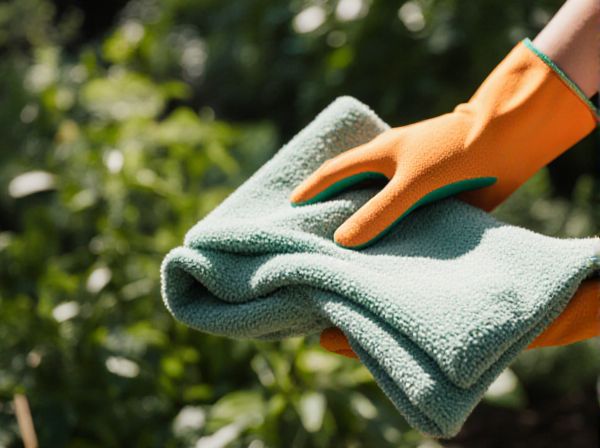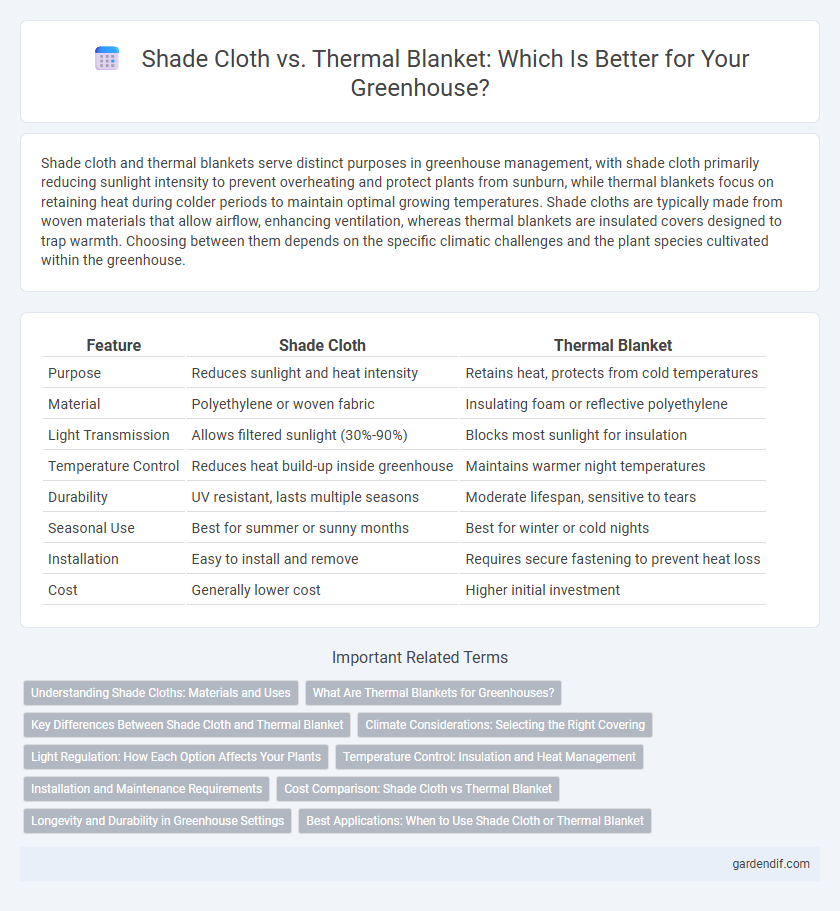
Shade Cloth vs Thermal Blanket Illustration
Shade cloth and thermal blankets serve distinct purposes in greenhouse management, with shade cloth primarily reducing sunlight intensity to prevent overheating and protect plants from sunburn, while thermal blankets focus on retaining heat during colder periods to maintain optimal growing temperatures. Shade cloths are typically made from woven materials that allow airflow, enhancing ventilation, whereas thermal blankets are insulated covers designed to trap warmth. Choosing between them depends on the specific climatic challenges and the plant species cultivated within the greenhouse.
Table of Comparison
| Feature | Shade Cloth | Thermal Blanket |
|---|---|---|
| Purpose | Reduces sunlight and heat intensity | Retains heat, protects from cold temperatures |
| Material | Polyethylene or woven fabric | Insulating foam or reflective polyethylene |
| Light Transmission | Allows filtered sunlight (30%-90%) | Blocks most sunlight for insulation |
| Temperature Control | Reduces heat build-up inside greenhouse | Maintains warmer night temperatures |
| Durability | UV resistant, lasts multiple seasons | Moderate lifespan, sensitive to tears |
| Seasonal Use | Best for summer or sunny months | Best for winter or cold nights |
| Installation | Easy to install and remove | Requires secure fastening to prevent heat loss |
| Cost | Generally lower cost | Higher initial investment |
Understanding Shade Cloths: Materials and Uses
Shade cloths are typically made from woven or knitted polyethylene fibers, designed to block specific percentages of sunlight, providing protection against excessive heat and UV radiation in greenhouse environments. These materials allow air circulation while reducing light intensity to optimize plant growth and prevent overheating. Shade cloths are versatile for seasonal use, offering adjustable shading options compared to thermal blankets, which primarily insulate against cold temperatures.
What Are Thermal Blankets for Greenhouses?
Thermal blankets for greenhouses are specialized coverings designed to retain heat and protect plants from cold temperatures, enhancing energy efficiency and extending growing seasons. Made from insulating materials like woven polypropylene or polyethylene, these blankets reduce heat loss by trapping warm air inside the greenhouse structure. Unlike shade cloths that primarily block sunlight and reduce heat, thermal blankets focus on minimizing thermal transfer to safeguard plants during frosty conditions.
Key Differences Between Shade Cloth and Thermal Blanket
Shade cloth primarily reduces sunlight intensity, lowering temperature and protecting plants from excessive heat, while thermal blankets provide insulation, retaining heat to protect plants from cold temperatures and frost. Shade cloth is made of woven or knitted fabric allowing air and water passage, whereas thermal blankets are thicker, often made from materials like polyethylene or polyester with foam layers to trap warmth. The choice between them depends on climate needs: shade cloth suits hot, sunny conditions, and thermal blankets are ideal for frost-prone, cooler environments.
Climate Considerations: Selecting the Right Covering
Shade cloths effectively reduce sunlight intensity, making them ideal for hot, sunny climates to prevent overheating in greenhouses. Thermal blankets provide insulation by trapping heat, essential for colder regions to maintain optimal growing temperatures during frost or low-pressure weather. Choosing between shade cloth and thermal blankets depends on local climate conditions and the specific temperature regulation needs of the greenhouse environment.
Light Regulation: How Each Option Affects Your Plants
Shade cloth reduces sunlight intensity by filtering UV rays, creating a cooler environment that prevents plant stress from overheating. Thermal blankets trap heat and light, offering insulation that maintains warmth during colder periods but may limit light penetration. Choosing between shade cloth and thermal blanket depends on the specific light requirements and temperature tolerance of your greenhouse plants.
Temperature Control: Insulation and Heat Management
Shade cloth reduces sunlight intensity, lowering greenhouse temperatures through ventilation and shading but offers limited insulation against cold. Thermal blankets provide superior heat retention by trapping warmth and minimizing heat loss during cooler periods, enhancing insulation efficiency. Combining both materials can optimize temperature control by balancing heat reduction during the day and heat preservation at night.
Installation and Maintenance Requirements
Shade cloth installation involves simple mounting on the greenhouse frame using clips or tie-downs, allowing for easy adjustment and removal. Thermal blankets require more precise installation with secure fastening systems to ensure full coverage and insulation, often demanding seasonal setup changes. Maintenance for shade cloth is minimal, involving occasional cleaning and inspection for tears, whereas thermal blankets need careful storage, regular checks for mold or damage, and proper handling to preserve insulation efficiency.
Cost Comparison: Shade Cloth vs Thermal Blanket
Shade cloths generally offer a more cost-effective solution for shading greenhouses, costing between $0.10 and $0.50 per square foot, while thermal blankets typically range from $0.75 to $2.00 per square foot due to their insulation properties. The initial investment in thermal blankets is higher, but they provide additional energy savings by reducing heat loss during cold months. For growers prioritizing budget, shade cloths deliver essential sun protection at a lower upfront cost, whereas thermal blankets justify their premium through extended climate control benefits.
Longevity and Durability in Greenhouse Settings
Shade cloths are designed to provide UV protection and moderate shading, typically lasting 3 to 5 years in greenhouse environments due to their resistance to sun damage and tearing. Thermal blankets offer enhanced insulation and temperature regulation but generally have a shorter lifespan of 1 to 3 years because of their sensitivity to moisture and frequent handling. In terms of durability, shade cloths outperform thermal blankets in long-term greenhouse use, making them a more sustainable choice for extended protection.
Best Applications: When to Use Shade Cloth or Thermal Blanket
Shade cloth is best used during hot, sunny periods to reduce light intensity and lower greenhouse temperatures, protecting plants from heat stress and sunburn. Thermal blankets are ideal for cold nights or frost conditions, providing insulation that retains heat and prevents temperature fluctuations inside the greenhouse. Selecting the appropriate material depends on seasonal climate challenges and specific crop temperature requirements.
Shade Cloth vs Thermal Blanket Infographic

 gardendif.com
gardendif.com